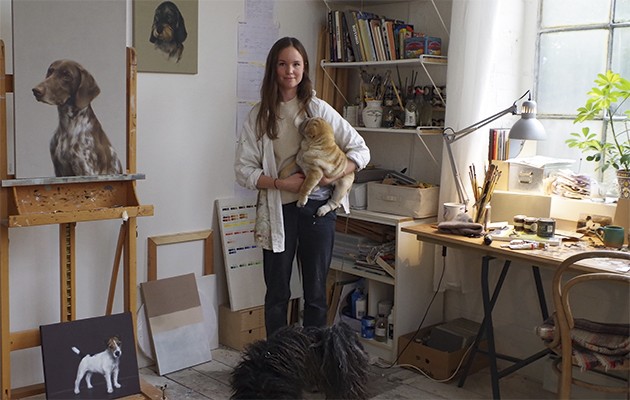Unlike birds or horses, dogs have rarely taken centre stage in sporting art. This could all change if the contemporary canine portraits by Bee Griffith are anything to go by, says Janet Menzies
Bee Griffith refuses to dismiss dogs in her artwork, even though the sporting art world can all too often forget man’s best friend. Her beautiful canine portraits could signal their time is finally coming.
For more exceptional sporting artists, take a look at Jonathan Sainsbury and his specialised artwork of birds, or Sir Alfred Munnings for some classic inspiration.
BEE GRIFFITH
Despite their undoubted magnetism, dogs generally do not inspire great art. There is Landseer, of course, and Warhol painted his dachshund, while George Rodrigues created the Blue Dog series. But there is really no canine equivalent of Audubon’s birds or Stubbs’s horses, leaving dogs in art from Gainsborough to Gaugin with little more than a walk-on role. However, if the work of Bee Griffith continues to develop, it seems there may be hope that canines could put a paw in the direction of becoming a painterly portrait subject.
Graduating from Goldsmiths College in 2012 with the Burston Prize for painting, Bee Griffith went on to be shortlisted for the Catlin Art Prize, which showcases the work of a select handful of young artists with “the potential to make a significant mark in the art world”. Griffith exhibited a challenging series of female nudes. These are not easy paintings to look at, and Bee Griffith confesses that her early success has sometimes been problematic. “When I first came out of Goldsmiths, I was working towards a couple of exhibitions and I found it very difficult. I was panicking and felt lost. I didn’t feel ready to make new work, but I had these two exhibitions and trying to force work out for those was awful. In the end I had to cancel one.”
Early fame is fine on reality TV, but getting a lot of attention can be intrusive for a young artist, as Griffith explains. “I prefer to be in the studio without anyone noticing what I am doing, so it can be intimidating to think people are expecting a lot of painterly work.”
Dogs entered the picture when a cousin asked Bee Griffith to do a painting of her dog. “So much of all this is chance,” says Griffith. “With art, you aren’t able to steer your career in a determined way as you can with some other professions – it takes control of you instead.”
If art grabs hold of someone, this has applied to Griffith’s dog portraits for, in just over a year, she has a growing and enthusiastic clientele.
“My mother is also an artist, working in the medium of glass engraving,” says Griffith, “and she always wanted me to be a portrait artist, but that’s a crowded field and I wasn’t sure I could make a living at it. But, as I enjoyed painting the first dog, it occurred to me how little there was out there in animal portraiture that I would actually want to have in my home.”
Tactfully glossing over all the truly ghastly paintings of family-favourite dogs that fail to adorn every British home, from baronial mansion to bungalow, Bee Griffith comments, “Animal painting tends to be traditional and so I thought there might be space for something a little more contemporary in style. My dogs are lighter in feel than my other work, and there is a subtle humour in them that my clients appreciate. They are consciously portraits, but of dogs rather than humans, and it reminds you how much a dog is a member of the family.”
Dogs do demand to be noticed and Griffith has realised that they are a worthwhile subject for the full range of her skills. “The dogs were giving me some breathing space,” she says, “and I thought the two strands of my art would be separate, but gradually I stopped thinking in that way. I have realised that there is a lot more development still to come with my dog portraits, which I am working out now.
“For instance, I have been using a very flat background but now I think I would like to make this more complex and painterly, to put the dog in the position where the human would be in an 18th-century master portrait. I spend a lot of time talking to people about their dogs, as I feel it is important to get the animal’s character across.”
In doing that, Bee Griffith could well end up as a “human” portraitist without a single person in her paintings. And if she succeeds in her mission to bring true painterly skills to canine portraiture, there may well come a day when someone admiring your dog’s portrait gives you the opportunity to boast, “Oh yes, it’s a Griffith.”
To commission Bee Griffith, call her on 07795 245718, email beegriffith@hotmail.co.uk or visit www.beegriffith.com.





